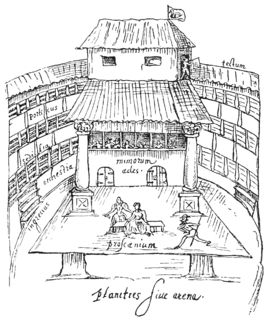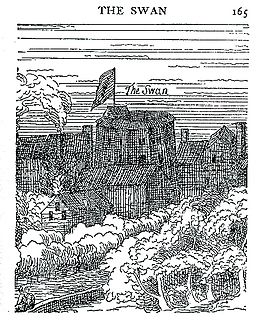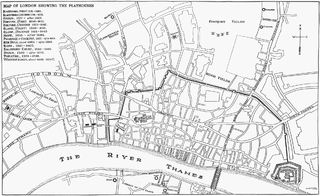
English Renaissance theatre, also known as Renaissance English theatre and Elizabethan theatre, refers to the theatre of England between 1562 and 1642.
Philip Henslowe was an Elizabethan theatrical entrepreneur and impresario. Henslowe's modern reputation rests on the survival of his diary, a primary source for information about the theatrical world of Renaissance London.

The Swan was a theatre in Southwark, London, England, built in 1595 on top of a previously standing structure, during the first half of William Shakespeare's career. It was the fifth in the series of large public playhouses of London, after James Burbage's The Theatre (1576) and Curtain (1577), the Newington Butts Theatre and Philip Henslowe's Rose (1587–88).
The King's Men is the acting company to which William Shakespeare (1564–1616) belonged for most of his career. Formerly known as the Lord Chamberlain's Men during the reign of Queen Elizabeth I, they became the King's Men in 1603 when King James I ascended the throne and became the company's patron.

The Red Bull was an inn-yard conversion erected in Clerkenwell, London operating in the 17th century. For more than four decades, it entertained audiences drawn primarily from the City and its suburbs, developing a reputation over the years for rowdiness. After Parliament closed the theatres in 1642, it continued to host illegal performances intermittently, and when the theatres reopened after the Restoration, it became a legitimate venue again. There is a myth that it burned down in the Great Fire of London but the direct reason for its end is unclear.

Nathan Field was an English dramatist. He was also an actor.

John Fletcher (1579–1625) was a Jacobean playwright. Following William Shakespeare as house playwright for the King's Men, he was among the most prolific and influential dramatists of his day; during his lifetime and in the early Restoration, his fame rivalled Shakespeare's. He collaborated on writing plays with Francis Beaumont, and also with Shakespeare on two plays.
Queen Anne's Men was a playing company, or troupe of actors, in Jacobean era London. In their own era they were known colloquially as the Queen's Men — as were Queen Elizabeth's Men and Queen Henrietta's Men, in theirs.
Robert Jones was an English lutenist and composer, the most prolific of the English lute song composers.

The Mermaid Theatre was a theatre encompassing the site of Puddle Dock and Curriers' Alley at Blackfriars in the City of London, and the first built in the City since the time of Shakespeare. It was, importantly, also one of the first new theatres to abandon the traditional stage layout; instead a single tier of seats surrounded the stage on three sides.

Philip Rosseter was an English composer and musician, as well as a theatrical manager. His family seems to have been from Somerset or Lincolnshire, he may have been employed with the Countess of Sussex by 1596, and he was living in London by 1598. In 1604 Rosseter was appointed a court lutenist for James I of England, a position he held until his death in 1623. Rosseter is best known for A Book of Ayres which was written with Thomas Campion and published in 1601. Some literary critics have held that Campion wrote the poems for Rosseter's songs; however, this seems not to be the case. It is likely that Campion was the author of the book's preface, which criticizes complex counterpoint and "intricate" harmonies that leave the words inaudible. The two men had a close professional and personal relationship; when Campion died in 1620, he had named Rosseter his sole heir.

The Cockpit was a theatre in London, operating from 1616 to around 1665. It was the first theatre to be located near Drury Lane. After damage in 1617, it was named The Phoenix.

The Whitefriars Theatre was a theatre in Jacobean London, in existence from 1608 to the 1620s — about which only limited and sometimes contradictory information survives.
The Children of the Chapel are the boys with unbroken voices, choristers, who form part of the Chapel Royal, the body of singers and priests serving the spiritual needs of their sovereign wherever they were called upon to do so. They were overseen by the Master of the Children of the Chapel Royal.
The Lady Elizabeth's Men, or Princess Elizabeth's Men, was a company of actors in Jacobean London, formed under the patronage of King James I's daughter Princess Elizabeth. From 1618 on, the company was called The Queen of Bohemia's Men, after Elizabeth and her husband the Elector Palatine had their brief and disastrous flirtation with the crown of Bohemia.
Prince Charles's Men was a playing company or troupe of actors in Jacobean and Caroline England.

The Hope Theatre was one of the theatres built in and around London for the presentation of plays in English Renaissance theatre, comparable to the Globe, the Curtain, the Swan, and other famous theatres of the era.
Queen Henrietta's Men was an important playing company or troupe of actors in Caroline era in London. At their peak of popularity, Queen Henrietta's Men were the second leading troupe of the day, after only the King's Men.
Robert Daborne was an English dramatist of the Jacobean era.
The Boar's Head Theatre was an inn-yard theatre in the Whitechapel area of London from 1598 to around 1616.









